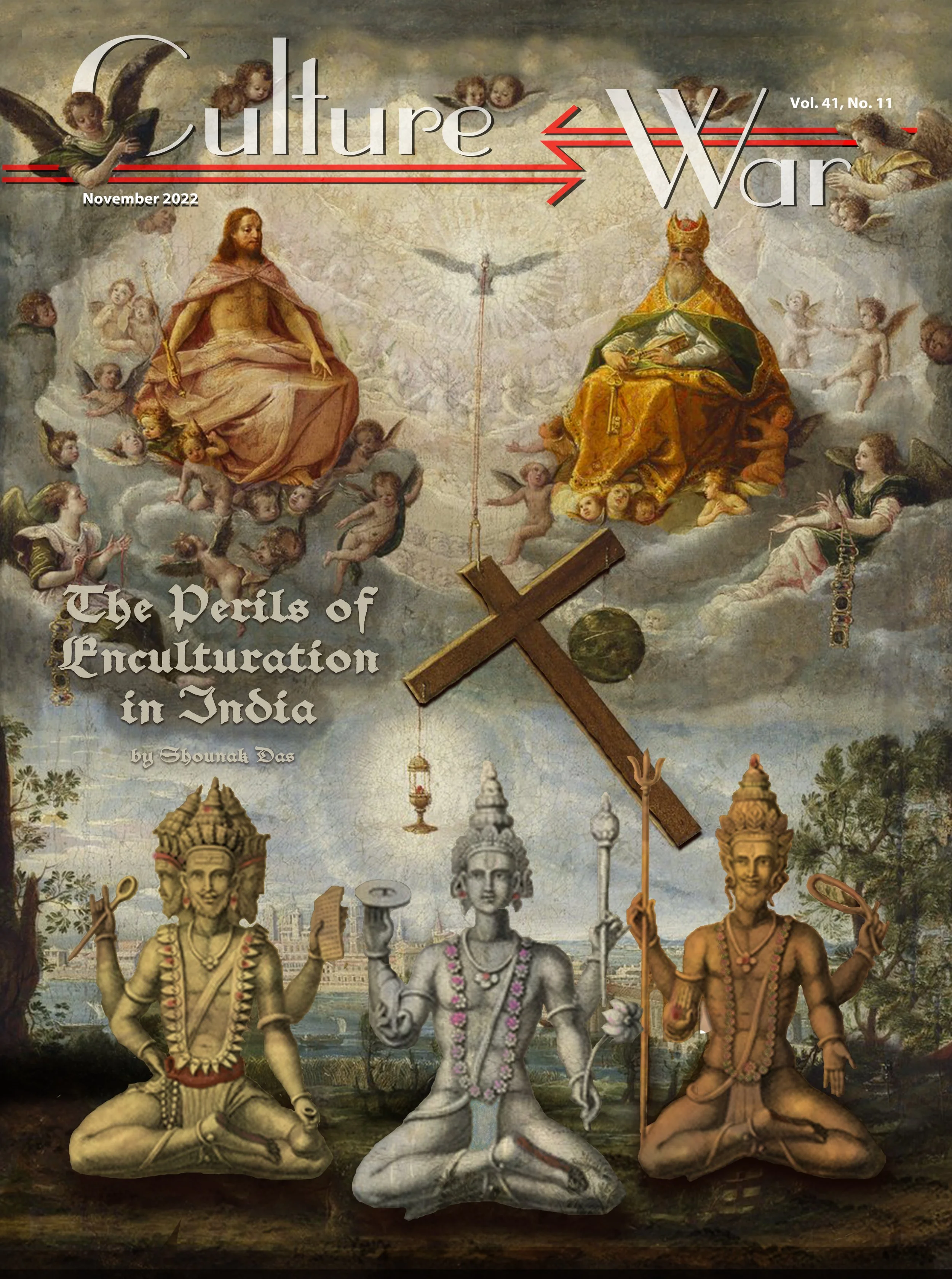The Problem of an Incarnate God
/Extraterrestrial Intelligence and the Catholic Church: Are We Alone in the Universe with God and the Angels? by Paul Thigpen, (Tan Books, 2022), Hardback, ISBN 978-1-5051-2013-4
Reviewed by Robert Sungenis
Buckle up and prepare for a wild ride. After a lifelong contemplation of the subject, popular author Paul Thigpen has decided to make a case for aliens living on other worlds, and perhaps visiting ours. Catholics will be interested in what he has to say because Paul attempts to use scriptural, magisterial, and traditional sources to support his pro-alien view. The book is 433 pages, half of which is an historical overview of the subject from Plato to Pope John Paul II.
The research it must have taken to collect and collate everyone who ever had a published thought about aliens is remarkable. I think Paul’s is the first book to do so. So if you want a “Who’s Who?” on which side someone was on in the debate about aliens, Paul’s book is the place to go.
Here are some examples of some of the more famous names in history who took sides on the issue. Those marked Y gave at least some indication of the possibility for other inhabited worlds, although some who said Yes qualified it by adding that although God could do it, he didn’t do it.1
Out of this list of 66 names, 25 said No to the possibility of aliens, while 41 said Yes, with 2 unknown. Of the list of 39 in the footnote, 18 said No and 27 said Yes, with 2 unknown. So the Yeses have it by about 65%. This may not mean much since we don’t know what kind of selection process Paul employed. One interesting note is that most of the No votes come from those who lived before the Copernican revolution. I will say more about the Copernican revolution and its relation to aliens later in my review.
Aristotle: N; Plato: Y; Plutarch: Y; Origen: Y; Jerome: N; Augustine: N; Hippolytus: Y; Chrysostom: Y; Athanasius: Y; Pope Zachary: N; Albert the Great: N; Roger Bacon: N; Aquinas: N; Ockham: N; Buridan: N; Oresme: N; David Wilkinson: N?; Bonaventure: N; Nicholas of Cusa: Y; Giordano Bruno: Y; Melanchthon: N; Johannes Kepler: Y; Galileo: Y; Caccini: N; Riccioli: N; Descartes: Y; Huygens: Y; Issac Newton: Y; George Bentley: Y; John Locke: Y; George Berkeley: Y; Godfried Leibniz: Y?; C. S. Lewis: Y; Edm. Halley: Y; Alexander Pope: Y; Immanuel Kant: Y; Martin Luther: ?; Gassendi: Y; J. Hutchinson: N; Boscovich: Y; Emm. Swedenborg: Y; Joseph Smith: Y; Ellen White: Y; Ben Franklin: Y; John Adams: Y; Thomas Paine: Y; Cotton Mather: Y; John Wesley: N; John H. Newman: N?; Thomas Huxley: N?; Charles Darwin: ?; Flammarion: Y; Anne C. Emmerich: Y; Fr. Stanley. Jaki: N; Garrigou-Lagrange: N; Pierre de Chardin: Y; Yves Congar: Y; Karl Rahner: N; Padre Pio: Y; Paul VI: Y; John Paul II: Y?; Paul Davies: Y; Francis Crick: N; Pat Robertson: N; Fr. D. Longenecker: N; Fr. George Coyne: Y
E. McMullin: Y?
Once you get past the vast history of opinions on aliens, Paul gives his own ideas in the latter half of the book, and he is certainly happy that the history shows he is not a lone wolf howling in the night.
But it is here I began to ponder what would have made someone like Paul Thigpen go so far in trying to prove what appears to be an unprovable case. From where was the passion coming that leads Paul to answer every possible objection he could think of?
There were at least two strong motivators. One of them doesn’t appear until the last chapter, which is titled “What about UFOs?” There Paul recommends the 2010 book by investigative journalist, Leslie Kean, titled, “UFOs: Generals, Pilots, and Government Officials Go on the Record.” Commenting on Kean’s work, Paul says, “In fact, it was Kean’s reporting for The New York Times that prompted the writing of the present book,” although Paul adds, “I have wanted to write on this subject for many years…” (p. 364).
The Influence of C. S. Lewis' Alien Fiction
As for the other motivator, one thing I noticed over and over again was Paul’s passionate devotion to C. S. Lewis. In fact, if I counted up the references correctly, Paul quotes from C. S. Lewis more than any other author of the last two thousand years. At times it appeared Paul’s book was an apology for Lewis and Lewis’ repertoire of science fiction novels, many of them about aliens, a subject that Paul says he has been contemplating from childhood with a late friend of his. Hence it appears Paul had already been desensitized to the idea of alien existence long before he wrote his book.
Pauline Baynes Illustration, Puzzle and Shift in The Last Battle
C. S. Lewis’ notion of the “cosmic Christ” plays prominently in Paul’s assortment of catch phrases that are supposed to bring us to a quick understanding of the possibility that Christ has and will be redeeming aliens until the end of time.
One of Lewis’ more popular works, The Chronicles of Narnia, which features a lion named Aslan, Paul informs us that the popular notion of Aslan being “an allegorical figure of Christ” who “creates the world of Narnia and dies on behalf of a sinner and rises again, and in the end, he judges all the creatures of that fanciful world,” is wrong. To correct it, Paul quotes from Lewis himself, saying,
“Aslan is an invention giving an imaginary answer to the question, ‘What might Christ become like if there really were a world like Narnia and he chose to be incarnate and did and rose again in that world as he actually has done in ours? This is not an allegory at all” (pp. 315-316).
In other words, C. S. Lewis’ primary intention was not to give an allegory as to what Christ already did but to propose what he might still do for the aliens of the universe. In that sense, Lewis’ work is more of what we might call a docu-novel in which fictional characters represent realities that the author believes are true. We know we are following Lewis’ bread crumbs because Mr. Thigpen says just a line later,
“In this light, Aslan might prompt us to consider: Given the problematic implications of the ‘cosmic Christ’ notion, if intelligent extraterrestrial races exist, might multiple incarnations of God in different species be possible? (p. 316).
What this tells us of Paul’s thinking process as he wrote the book is that he knew it had to be an all or nothing endeavor. That is, he couldn’t just raise the question of alien existence that one might find on television documentaries like Unsolved Mysteries. Once Paul put his toe in this water he couldn’t leave without diving deep into the Christian doctrine of the atonement since, for Christians, the topic of alien existence merely begs the question concerning what relationship aliens would have to God, and especially in the area of the last four things.
This forces Paul to go into a whole array of speculative theological thoughts, some of them quite bizarre to the uninitiated, about how God would manifest himself to aliens; or even whether aliens were considered sinful and needed to be redeemed in the first place. Often when Paul gets into a sticky theological wicket, he calls C. S. Lewis to the rescue to help him out of the conundrum, even though Lewis was not Catholic.
Multiple Marys and Multiple Christs to Save Multiple Aliens
Toward the end, Paul comes to the point of having to admit that his notion of redeeming aliens must include the possibility of having multiple Marys to produce the multiple Christ’s that will have to assume multiple alien physiologies. Surprisingly, Paul’s only reticence to this weird proposal is that we need not worry if Mary would lend herself to be multiplied because, being humble, Mary would present no competition to the alien Marys who are to bring alien Christ’s to the universe’s multitude of aliens. I will allow Paul to say it in his own words:
“Instead, I mean that the Son of God, the eternal Second Person of the Blessed Trinity, might unite to Himself the nature of one or more intelligent extraterrestrial races. This means we would not be talking about multiple Persons; He would be, in each incarnation, the very same divine Person, the Son of God. But that one divine Person would have joined to Himself numerically distinct, multiple natures of created rational races, and made them His own, in the kind of hypostatic union that Saint Thomas was describing” (p. 319).
As for Mary and multiple Marys, Paul adds,
“If the divine Son of God should become incarnate in extraterrestrial races, then His mother on other planets could also be rightly called the ‘Mother of God.’ He would, in fact, have several mothers—though their multiplicity would do nothing to diminish the exalted dignity of each one” (p. 346).
“Finally, even if there are multiple incarnations with multiple Mothers of God and of the Church, who are also multiple Queens of the Universe through the divine Majesty of their Son, the modest mother of Jesus that I know would not consider herself dishonored or diminished in any way. Nor would she view her ‘sisters’ as rivals or be jealous of them. She is Mother Most Humble” (p. 347).
At this point Paul steps back a bit and admits, “We are in admittedly deep waters here, and if I offer any speculations that the Church should later rule out, I will be the first to reject them” (p. 346).
When Paul’s logic led him to the point that he had to envision multiple Christs and multiple Marys to make saving various aliens redemptively feasible, one wonders whether at this point Paul had thoughts of abandoning the whole endeavor because the waters were not only deep they were becoming an abyss.
But Paul trudged onward. One of Paul’s constant refrains is that we can’t deny him the right to write his book and express his personal speculations about aliens because, after all, “anything is possible for God.” Paul repeats this phrase so often it becomes a rhetorical device to ward off any critic who might think Paul has gone too far or gone off the edge entirely.
Dominus Jesus
One of the better examples in the book of Paul’s reluctance to question his position, even in the face of what others see as a strong hint that Paul is on the wrong track, is Paul’s treatment of the 2000 document, Dominus Jesus, written by Cardinal Joseph Ratzinger, at that time Prefect of the CDF.
First, Paul admits that Dominus Jesus has been “cited as evidence that the existence of multiple incarnations would be contrary to the teaching of the Church” (p. 330). But as a mother defending her tormented child, Paul quickly reminds us that Dominus Jesus “is not infallible, nor does it even carry the weight of a papal encyclical,” yet admits “it was ratified and confirmed by Pope Saint John Paul II” and admits it “takes up what has been taught in previous magisterial documents…that are part of the Christian faith” (p. 331).
Next Paul gives us a list of the half dozen times that Dominus Jesus says that salvation is only for the human race, and he even italicizes such phrases as “salvific revelation of God to humanity,” and “Jesus Christ has a significance and a value for the human race and its history, which are unique and singular, proper to him alone, exclusive, universal, and absolute” (p. 332).
[…] This is just an excerpt from the November 2022 Issue of Culture Wars magazine. To read the full article, please purchase a digital download of the magazine, or become a subscriber!
(Endnotes Available by Request)









